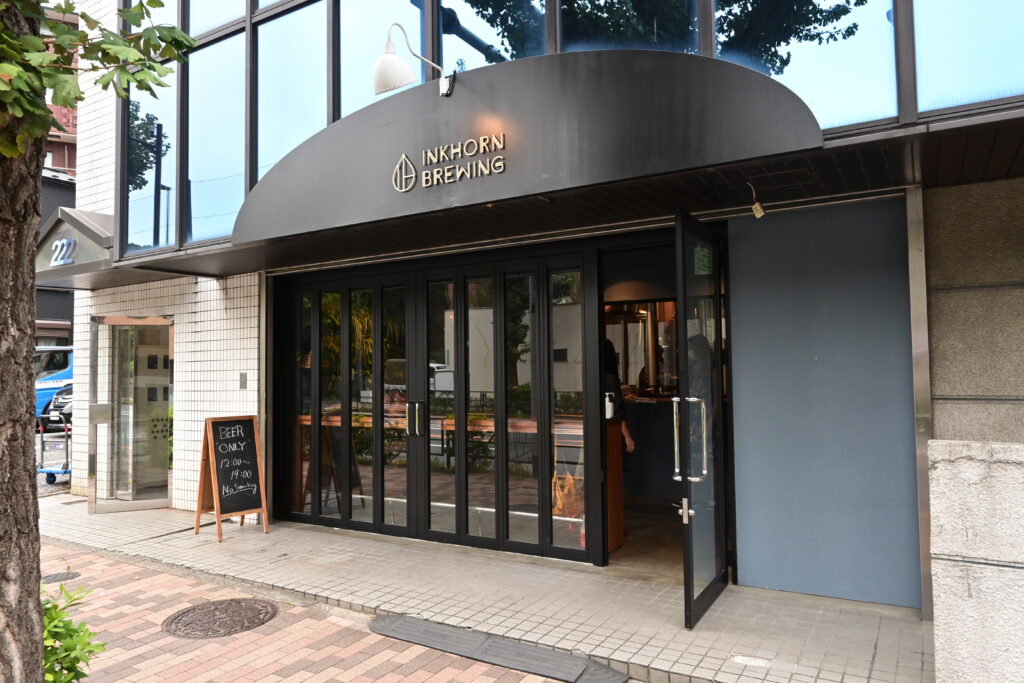It’s so hard to turn away a good beer. Once I take a sip of a well-made one, resistance is futile and I dive right in. For those of us serious fans, it’s times like these where a sip might as well be a pint. On this occasion, I was drinking a few “sips” of beer brewed by Shun Nakade, founder and brewmaster of Inkhorn Brewing. As he watched me enjoy his creations, Nakade was grinning like a proud Cheshire cat. The diving on this occasion was close to Olympic level and I was going for the gold.
Nakade was born in Tokyo’s Koto Ward. He says that his parents were passionate about fine food and drink, leading him to develop a taste for quality cuisine at a young age. After graduating from junior high school in Japan, he attended high school in Oregon. Being a fan of Seattle area greats Jimi Hendrix and Nirvana, he decided to move to the city after high school to study music theory and psychology. Talk of the US Pacific Northwest evokes images of an outdoorsy culture with a brewery seemingly on every corner. While this is not a big stretch from reality, it wasn’t the impression Nakade initially had. He reveals, “When I was in the US, I didn’t recognize craft beer as craft beer. When I returned to Japan, I was surprised that there were really no beers similar to what I had been drinking.”
Back in Japan, he spent a great deal of time going to bars specializing in German and Belgian beer. He would occasionally travel to the US to make the rounds at homebrew stores and try his hand at making beer. So in the early 2010s, while doing administrative work and acting as a translator/interpreter at a local international school, Nakade basically lived the lifestyle of a so-called “beer geek”. Eventually, that evolved into a desire to become a professional brewer. Reminiscing about that time, he says, “I thought the beer industry would be good for me, however, I also felt like I couldn’t get into it unless I had connections.”
In 2018 that connection materialized. Through an acquaintance, he became involved in the launch of a brewpub called PITMANS in the Kiyosumi-shirakawa neighborhood of Koto Ward, Tokyo. It was here that he had his first opportunity to brew commercially. Building on his homebrewing experience, the hands-on work at the brewpub allowed him to add more tools to his kit. After a while, he earned the trust of the head brewer, and was soon left to brew on his own. In his free time, he assisted Choshi Beer and Tsukuba Brewery, which both had similar equipment to what he was using. He instructed them in its operation, recipe creation, and other brewing-related matters, while also making beer with them. “We had already decided to open Inkhorn in 2020, so I traveled around collaborating with different breweries until we could open our taproom. When the doors finally opened in January 2021, we mainly served those collaboration beers,” Nakade says.
He had been involved in the start-up of several other breweries, but when it came to his own, how different was it? Nakade answers, “I knew the general workings of a brewery itself and had a good concept of how to bring in the equipment, but I knew little about running a drinking establishment. I didn’t know what was necessary to apply for a food and beverage license. It was tough without someone with expertise in that area to rely on.” To that he adds, “After the tanks were forklifted in, we had to carry them by hand! I got some much needed assistance from the team at Tokyo Aleworks.” At this point he expresses a great deal of gratitude to his hard-working, neighborhood brewing brethren.
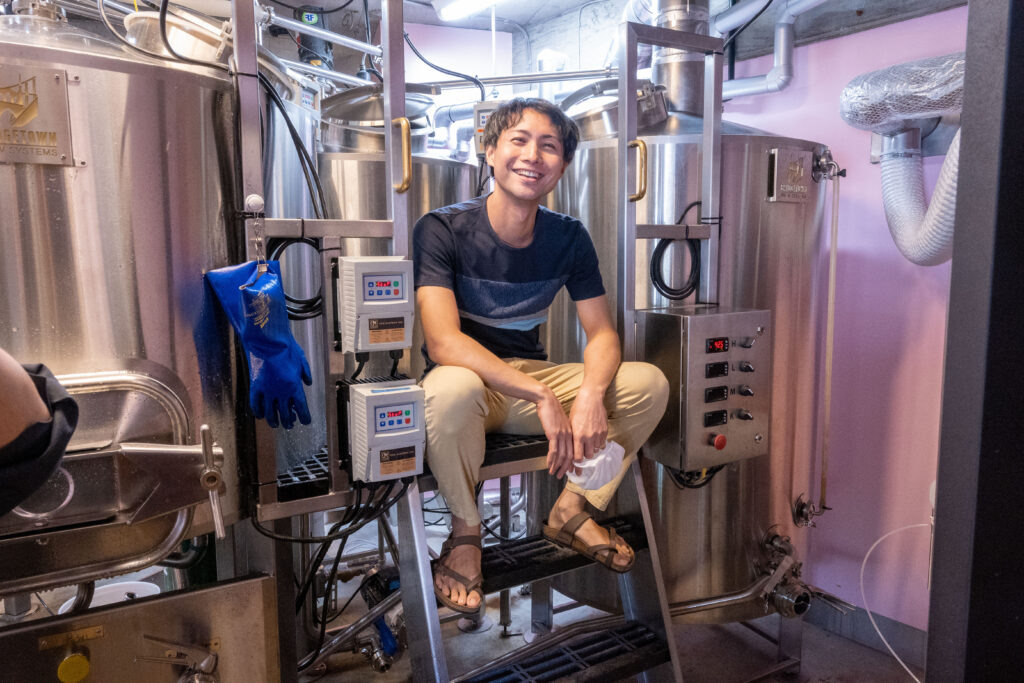
The brewery’s name, “Inkhorn”, refers to animal horn inkwells that were once commonly used in Europe. In the 16th and 17th centuries, there was a widespread tendency among elite English scholars and writers to show off their language skills by using words borrowed from classical literature (most commonly Latin). As these authors were the primary users of the inkwells, these loan words came to be known as inkhorn terms. Some deemed this pretentious resulting in a prevalence of disputes on the matter. Nakade explains, “There was a debate at the time about whether or not this trend infringed on the purity of the English language. Many questioned why words of foreign origin should be included in English. I was somewhat fascinated by this.” When I heard Nakade’s telling of the story, what immediately came to mind was the use of katakana for Japanese words by some politicians to seem more sophisticated or trendy. I was struck by the universal nature of the argument.
Nakade continues, “Additionally, I feel that the inkwell is a fountain of inspiration because ink transforms into words and stories. Also, inkwells are often found in studies or libraries. I feel at home in that kind of atmosphere. Another part of it is we are poking fun at ourselves imagining that we are elite intellectuals (laughter).”
At this point, Amy Holdsworth, Nakade’s wife and co-founder, jumps in. “Shun is a Japanese brewer, but takes inspiration from conversations with brewers around the world–German, American, et cetera. So we thought it would be appropriate in that sense as well.”
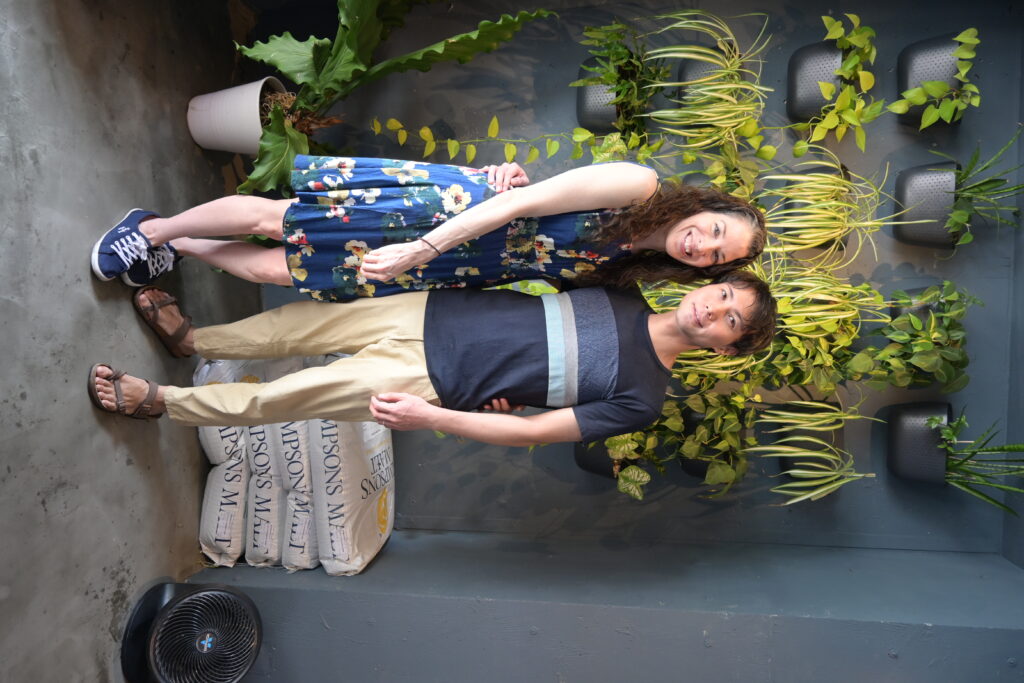
She is wearing a colorful, sleeveless dress consistent in spirit with her visual contributions to the brewpub. Holdsworth has been helping Inkhorn create its concept as a brand and designing the interior of the taproom while working another job. Her home state of Connecticut (US) is home to the Audubon Society Coastal Center, a sanctuary for birds and other wildlife. The couple has always been fond of birds and has a pet Java finch at home. You may notice that many of the beers at Inkhorn have avian-themed names. According to Nakade, the image of a feather pen sitting in the inkwell was one more reason the name Inkhorn seemed like an appropriate choice.
Inkhorn’s taproom is located on a busy road inside the Yamanote loop line less than ten minutes on foot from Mejiro Station. Look for the chic Inhorn logo above the entrance and follow the aroma of beer. In nice weather, the ground-floor, windowed storefront opens onto the sidewalk. Peering in, the brewing area is easily visible. Take your place at the counter and people watch to your heart’s content. The wooden interior is best described as stylish contemporary. The taps are set into a large, vivid mural of a Louisiana heron. It’s a reproduction of the cover of The Birds of America by 19th century naturalist/painter John James Audubon. Bird lover and Audubon fan Holdsworth chose this eye-catching backdrop. Standing with dignity, the heron seems to be presiding over the room, surveying patrons enjoying their beers. The wall on the opposite side of the room, full of planters with greenery springing forth into the room, is a refreshing contrast to the concrete and pavement beyond the brewery’s walls. The taproom serves as a downtown oasis, where the thirst-quenching water is flavored with malt and hops.
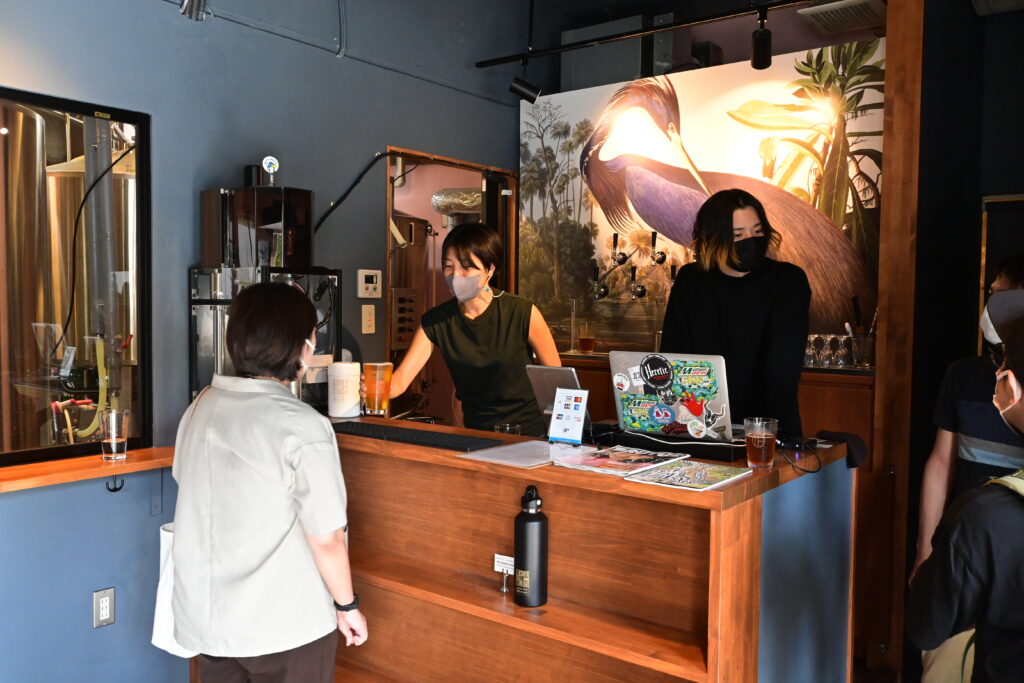
For the daily running of the taproom, Nakade is supported by manager Yui Kawashima and Yumi Sagawa, who helps out around once a week. In addition to managing the brewpub, Kawashima is tasked with shipping/receiving and acts as a liaison with the beer pubs making purchases. Like Nakade, he is a music lover, and on the side sings in a hardcore metal band, which has even toured overseas. His status as the frontman in a band may lead one to believe that he’s difficult to approach, but conversing with him reveals a diligent and sincere character. Add the bright smile of Sagawa to the mix, and the bar gives you a feeling of being among friends.
Through the windows of the taproom, you can view the brewing area, which is equipped with two 5-barrel (approximately 600L) tanks and two 10-barrel (about 1200L) tanks for double batches. Nakade brews about once a week, but he mentions that “it’s a lot of work for one person. Double batches are pretty much impossible for me to do on my own. Single batches are also exhausting and take a lot of time. So I solicit help from everyone.”
When I asked about his favorite types of beer, he says, “I mostly drink lagers. I prefer a hoppy pilsner that is not too high in alcohol and allows me to enjoy a balance of the malt and hops. I also like sours. Again, I prefer ones with a tamer ABV. In this case, I find myself finishing them before I know it.” He says that he doesn’t have any standard beers, but he consistently makes West Coast IPAs. Regarding the reason for this, he says with a grin, “It’s going to sound a bit lovey-dovey, but Amy really likes Galaxy hops, so I feel I need to make sure I always have a West Coast IPA that at least exhibits the characteristics of that hop. I quit a stable job and borrowed money from various people to start up this business. She has been very supportive of this endeavor and I can’t thank her enough.” His sentiments are also evidenced by the aforementioned bird theme in the beer names.
Nakade, who is particularly interested in highlighting the characteristics of hops, says that basically all his beers are dry-hopped. In regards to creating a recipe, he says, “I think of an IPA as a sum. It’s about how much hops the malt and the base beer can withstand, and then building on that concept. I feel that it’s easier to show the character of the hops if you construct the beer like Jenga and aim for the edge of collapse. I always want to walk that fine line. On the other hand, I think of pilsners as the realm of subtraction. After lagering, when the beer is ready to drink, many things fall away leaving only the distinct character of the malt and noble hops. If you add too much, you lose that delicate balance.”
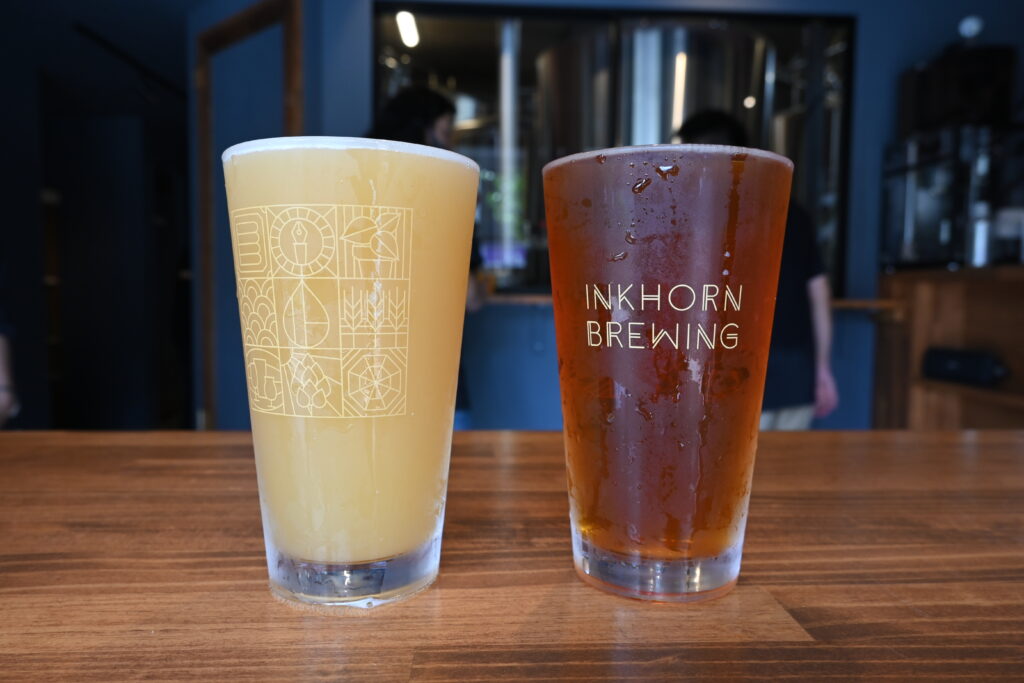
On the day I visited, there were seven kinds of beer on tap, five of which were Inkhorn originals. Flocc Members (ABV 5.3%), is an Italian pilsner, a style we featured in our previous issue (JBT47). Dry-hopped with German Diamant hops, this beer is slightly hazy with an elegant aroma. It has a clean, yet refined taste with fruitiness and solid bitterness on the palate. It’s a perfect beer for a sunny autumn day. Goldfinch (6.5%), a West Coast IPA, has a moderate bitterness for this style and goes down easy. It’s a well-balanced beer with tropical fruit aroma, tangy sourness, umami, and a pleasantly bitter aftertaste. My favorite beer of the day was Postsourism (6%), a sour IPA made with blackberries and currants. It has an eye-catching, bright reddish-purple hue resembling wine. As I inched the glass toward my nose, I was struck by the lively aroma of fresh berries. I felt as if I was in an aromatherapy session. The taste is dry and the berry flavor abundant, but not overly sweet or sour as one might imagine from the aroma. The hop bitterness lingering in the background added an IPA-like flavor component. This was a complex, well-constructed brew. The entire lineup was very satisfying. I was slightly worried that my glass seemed to be emptied at a rather quick pace, but the calming gaze of that heron on the wall keeping watch over me slowed me into maintaining a safe level of sobriety. If that is his purpose, he was doing some good work.
As for the future of Inkhorn, Nakade confesses, “I don’t think about it at all (laughs). I’m occupied with simply surviving each day. But if I do expand the business, I would like to open a second store overseas, preferably somewhere in Asia.” He also mentions that as soon as he can afford it, he would like to lend support to the children of Cambodia, where he spent time doing volunteer work as an English teacher when he was employed at the international school.
I mused on what other stories would emerge from Nakade with the support of his life partner and friends in the coming years. I left this urban oasis with high hopes for his future creations. Now I was the one grinning like a Cheshire cat.
This article was published in Japan Beer Times # () and is among the limited content available online. Order your copy through our online shop or download the digital version from the iTunes store to access the full contents of this issue.

